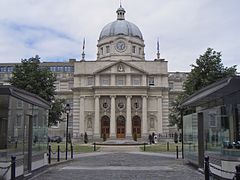Government Buildings
| Government Buildings | |
|---|---|
| Tithe an Rialtais | |

Main façade of Government Buildings
|
|
|
|
|
| General information | |
| Architectural style | Edwardian Baroque, neoclassical |
| Location | Merrion Street, Dublin, Ireland |
| Coordinates | 53°20′21″N 6°15′13″W / 53.339167°N 6.253611°W |
| Current tenants |
Department of the Taoiseach, Office of the Attorney General, Department of Finance, Cabinet Office, Department of Public Expenditure and Reform, |
| Construction started | 1904 |
| Completed | 1922 |
| Inaugurated | 1911 |
| Renovated | 1989–1990 |
| Cost | £225,000 pounds sterling (1904 est.) |
| Renovation cost | £17.4 million Irish pounds (1990) |
| Owner | Government of Ireland |
| Design and construction | |
| Architect | Thomas Manly Deane |
| Architecture firm | Aston Webb |
| Main contractor | McLaughlin & Harvey Ltd |
| Renovating team | |
| Architect | Office of Public Works |
| Renovating firm | Pierse Contracting |
| Awards and prizes | RIAI Silver Medal for Conservation (1987–92) |
Government Buildings (Irish: Tithe an Rialtais) is a large Edwardian building enclosing a quadrangle on Merrion Street in Dublin, Ireland, in which several key offices of the Government of Ireland are located. It was originally shared between the Dublin Castle administration and the Royal College of Science for Ireland. Among the offices of State located in the building are:
The building that was to become Government Buildings was the last major public building built under British rule in Ireland. The foundation stone for the building was laid by King Edward VII in 1904. It was built on the site of a row of Georgian houses that were being controversially demolished one by one as the new building was erected. The building itself was designed by Sir Aston Webb, a British architect who was later to redesign the facade of Buckingham Palace. The final completed building was opened by King George V in 1911.
It may have been intended for use by the Royal College of Science, but it soon attracted the attention of the Lord Lieutenant of Ireland's Dublin Castle administration. It was chosen to be the location for the first meeting of the new Parliament of Southern Ireland, created under the Government of Ireland Act 1920, in June 1921. The planned State Opening of Parliament proved a fiasco, as only four members of the House of Commons of Southern Ireland and a minority of members of the Senate of Southern Ireland turned up. The Houses were adjourned sine die (although under the Anglo-Irish Treaty on 14 January 1922 “a meeting of members of the Parliament elected for constituencies in Southern Ireland" met to ratify the Treaty).
...
Wikipedia

